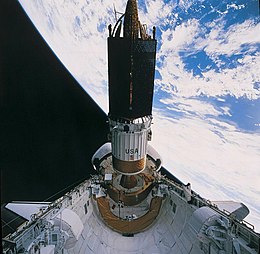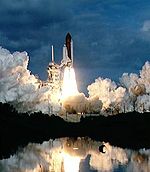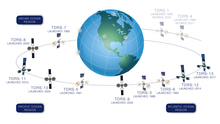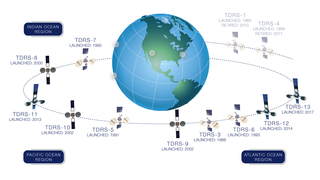
A tracking and data relay satellite (TDRS) is a type of communications satellite that forms part of the Tracking and Data Relay Satellite System (TDRSS) used by NASA and other United States government agencies for communications to and from independent "User Platforms" such as satellites, balloons, aircraft, the International Space Station, and remote bases like the Amundsen-Scott South Pole Station. This system was designed to replace an existing worldwide network of ground stations that had supported all of NASA's crewed flight missions and uncrewed satellites in low-Earth orbits. The primary system design goal was to increase the amount of time that these spacecraft were in communication with the ground and improve the amount of data that could be transferred. These TDRSS satellites are all designed and built to be launched to and function in geosynchronous orbit, 35,786 km (22,236 mi) above the surface of the Earth.
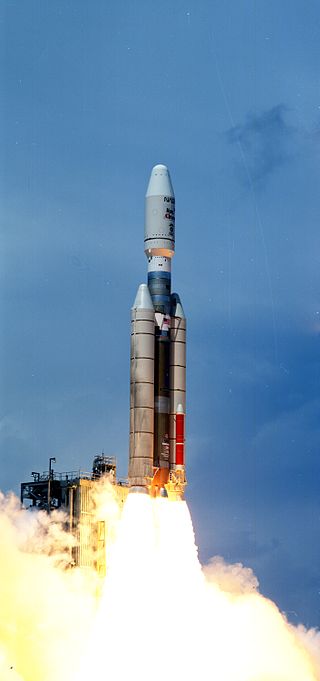
The Commercial Titan III, also known as CT-3 or CT-III, was an American expendable launch system, developed by Martin Marietta during the late 1980s and flown four times during the early 1990s. It was derived from the Titan 34D, and was originally proposed as a medium-lift expendable launch system for the US Air Force, who selected the Delta II instead. Development was continued as a commercial launch system, and the first rocket flew in 1990. Due to higher costs than contemporary rockets such as the Ariane 4, orders were not forthcoming, and the CT-3 was retired in 1992.

Intelsat 603 or IS-603, previously named Intelsat VI F-3, is a communications satellite operated by Intelsat. Launched in 1990, it was the second of five Intelsat VI satellites to be launched. The Intelsat VI series was constructed by Hughes Aircraft, based on the HS-389 satellite bus.
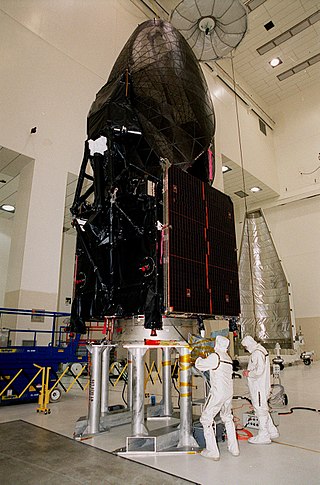
TDRS-8, known before launch as TDRS-H, is an American communications satellite, of second generation, which is operated by NASA as part of the Tracking and Data Relay Satellite System. It was constructed by Boeing is based on the BSS-601 satellite bus.

TDRS-B was an American communications satellite, of first generation, which was to have formed part of the Tracking and Data Relay Satellite System. It was destroyed in 1986 when the Space ShuttleChallenger disintegrated 73 seconds after launch.

TDRS-1, known before launch as TDRS-A, was an American communications satellite, operated by NASA as part of the Tracking and Data Relay Satellite System. It was constructed by TRW and launched by Space ShuttleChallenger on its maiden flight, STS-6.

INSAT-1B was an Indian communications satellite which formed part of the Indian National Satellite System. Launched in 1983, it was operated in geostationary orbit at a longitude of 74 degrees east. At the end of its seven-year design life it was replaced by the newly launched INSAT-1D, dropping to backup status. In 1992, it was relocated to 93° east, before being decommissioned in August 1993.

TDRS-5, known before launch as TDRS-E, is an American communications satellite, of first generation, which is operated by NASA as part of the Tracking and Data Relay Satellite System. It was constructed by TRW is based on a custom satellite bus which was used for all seven first generation TDRS satellites.
Thaicom 5 was a geostationary communications satellite operated by Thaicom. It was used to provide communications services to Asia, Africa, Middle East, Americas, Europe and Australia.
Orion 3 was an American spacecraft which was intended for use by Orion Network Systems, as a geostationary communications satellite. It was to have been positioned in geostationary orbit at a longitude of 139° East, from where it was to have provided communications services to Asia and Oceania. Due to a malfunction during launch, it was instead delivered to a useless low Earth orbit.
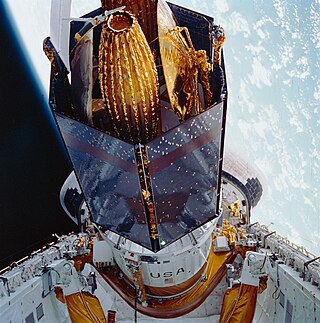
TDRS-3, known before launch as TDRS-C, is an American communications satellite, of first generation, which is operated by NASA as part of the Tracking and Data Relay Satellite System. It was constructed by TRW, and is based on a custom satellite bus which was used for all seven first generation TDRS satellites.

TDRS-4, known before launch as TDRS-D, is an American communications satellite, of first generation, which was operated by NASA as part of the Tracking and Data Relay Satellite System from 1989 until 2011. It was constructed by TRW, based on a custom satellite bus which was used for all seven of the first generation TDRS satellites.

TDRS-7, known before launch as TDRS-G, is an American communications satellite, of first generation, which is operated by NASA as part of the Tracking and Data Relay Satellite System. It was constructed by TRW as a replacement for TDRS-B, which had been lost in the Challenger accident, and was the last first generation TDRS satellite to be launched.

TDRS-9, known before launch as TDRS-I, is an American communications satellite which was operated by NASA as part of the Tracking and Data Relay Satellite System. It was constructed by the Boeing Satellite Development Center, formerly Hughes Space and Communications, and is based on the BSS-601 satellite bus. It was the second Advanced TDRS, or second-generation Tracking and Data Relay Satellite, to be launched.

TDRS-10, known before launch as TDRS-J, is an American communications satellite which is operated by NASA as part of the Tracking and Data Relay Satellite System. It was constructed by the Boeing Satellite Development Center, formerly Hughes Space and Communications, and is based on the BSS-601 satellite bus. It was the third and final Advanced TDRS, or second-generation Tracking and Data Relay Satellite, to be launched.
Prowler was an American reconnaissance satellite launched aboard Space ShuttleAtlantis in 1990 in order to study Soviet satellites in geosynchronous orbit. The government of the United States has never acknowledged its existence, however it has been identified by amateur observers and through leaked information.

TDRS-11, known before launch as TDRS-K, is an American communications satellite which is operated by NASA as part of the Tracking and Data Relay Satellite System. The eleventh Tracking and Data Relay Satellite is the first third-generation spacecraft.
INSAT-1A was an Indian communications satellite which formed part of the Indian National Satellite System. Launched in 1982, it was operated in geostationary orbit at a longitude of 74° east. Following a series of failures, the satellite was abandoned in September 1982, less than 6 months into a seven-year mission.

TDRS-12, known before launch as TDRS-L, is an American communications satellite operated by NASA as part of the Tracking and Data Relay Satellite System. The twelfth Tracking and Data Relay Satellite, it is the second third-generation spacecraft to be launched, following TDRS-11 in 2013.
Intelsat III F-3 was a geostationary communications satellite operated by Intelsat. Launched in 1969 it was intended for operations over the Pacific Ocean; however, it spent most of its service life over the Indian Ocean at a longitude of 63 degrees east.
